
IRIS login | Reed College home Volume 93, No. 1: March 2014
Thinker. Tailor. Soldier. Spy. (continued)
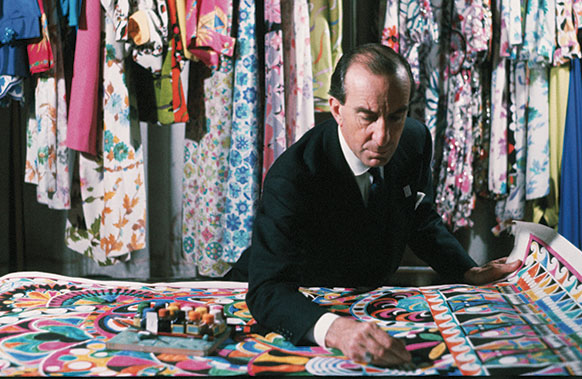
Innovative fabrics, bold designs. Pucci in Florence, 1959. © David Lees/Corbis
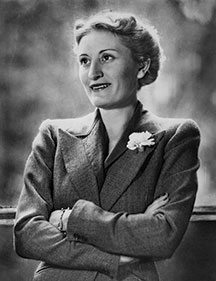
DAMSEL IN DISTRESS: Countess Edda Ciano, Mussolini’s daughter, turned to Pucci in a bid to rescue her husband.
© Hulton-Deutsch Collection/CORBIS
Honor and Treachery
After graduating from Reed, Emilio returned to Florence to find a letter he had been dreading—a government order to serve in the armed forces. He reported for duty in the Italian Air Force, starting in Ethiopia. He survived several fighter-pilot missions that destroyed the majority of his squadron and won a medal for valor before coming down with a debilitating tropical fever.
While recuperating in Capri in 1943, Emilio’s destiny was forever altered by a chance meeting with a childhood friend—Countess Edda Ciano, the eldest daughter of Italian dictator Benito Mussolini. Strong-willed and glamorous, she had volunteered with the Red Cross in Italy’s ill-fated invasion of Greece and had been aboard the Po, a hospital ship, when it was sunk by a British bomber. She survived by swimming to shore.
Agent of Mercy
At the end of WWII, Emilio Pucci, then living in exile in Switzerland, approached the Italian embassy about returning to his native land. The response was pessimistic: however honorable Emilio deemed his actions to save Countess Edda Ciano and to preserve the Ciano Papers, he had been officially AWOL from the Italian Air Force for nearly a year and a half. His only chance of returning to Italy as a free man was to cut a deal with the Allied forces who now occupied Italy.
Converging on that moment in time was Cordelia Dodson ’36, MA ’41, who worked in intelligence and counterintelligence at the Office of Strategic Services in Bern under Allen Dulles, the future director of Central Intelligence.
Fluent in French and German, Cordelia spotted Emilio’s name in cable traffic and volunteered her assistance. Dulles, anxious to track down the missing diaries, arranged for Cordelia to rendezvous with Emilio at Zermatt, an Alpine ski resort in the shadow of the Matterhorn. From that meeting, Cordelia produced a memo that included Emilio’s account of his role with the Cianos and got him to agree to look for the missing Ciano papers in Italy. At Cordelia’s suggestion, therefore, Dulles asked the Italians to let Emilio return without fear of imprisonment.
Cordelia’s career with the OSS, told in brief in the book Sisterhood of Spies: The Women of the OSS, reads like an adventure novel. Her assignments involved dangerous air missions and top-secret encryption. She married fellow OSS operative William J. Hood, and their secret duties took them to various locations in Central and Western Europe. Cordelia retired in 1980 to the coast of Maine, where she lived unobtrusively until her death at the age of 98.
Edda was married to one of her father’s most influential henchmen, Galeazzo Ciano. In the ’30s, Ciano had been Mussolini’s right-hand man, serving as chief propagandist and foreign minister. Over time, however, Ciano grew disillusioned. In July 1943, after the Allied invasion of Sicily, he turned against Mussolini and was soon imprisoned by Il Duce and his Nazi overlords on charges of treason.
Edda now found herself in a surreal situation—her father had essentially ordered the death of her husband. In desperation, she turned to Emilio.
Emilio’s youthful admiration for Mussolini had been shattered by the war. As he later said, “I had idealized fascism while I was abroad, and was confronted now with corruption, lack of responsibility, and incompetence. I still believed in fascism, however, thinking it was the men who were failing and not the system.”
To Emilio, however, ideology was nothing compared to a damsel in distress. Opined historian James H. Walters, Emilio “was a hangover of feudalism: a cavalier who felt it was his duty to lend his sword to his queen.” In Emilio’s own words: “After listening to her story, I decided that it was my duty as an officer and an Italian to do all I could to help her . . . and that it was my duty as a gentleman to do my utmost.”
At Edda’s behest, he agreed to intercede with Mussolini on her behalf, only to discover that, as she had predicted, Mussolini promised everything but did nothing. “If you only knew how many times I have tried to show him the truth,” she told Emilio. “There is nothing to be done through him.”
Mussolini claimed that he was powerless to release Ciano, who was in the hands of the Gestapo. Fortunately, Edda and Emilio did not have to rely on Mussolini’s conscience. They held a card that would prove to be one of the most significant documents of the entire war—Ciano’s secret diaries.
The Ciano diaries provided a blow-by-blow account of Mussolini’s inner circle from 1937 to 1943, plus incriminating revelations about top Nazi leaders. The diaries were the World War II equivalent of the Nixon tapes—political dynamite.
Knowing that Ciano could be executed at any time, Edda and Emilio tried to use the damning documents as a bargaining chip—an effort that plunged them into the infernal heart of Nazi politics as key players in the Third Reich, including Heinrich Himmler, Ernst Kaltenbrunner, and Joachim von Ribbentrop, vied for possession of the diaries. Himmler and Kaltenbrunner agreed to release Ciano in exchange for them, but Edda and Emilio had misgivings and held back the portion of the documents that dealt primarily with the Nazis—the so-called Germania papers.
They were right to be suspicious. The Germans had no intention of releasing Ciano. Deciding that it was too dangerous to stay in Italy, Emilio sewed a pouch in Edda’s jacket to smuggle the Germania papers across the border into Switzerland. After her successful escape, she mailed desperate letters to her father and Hitler, writing that if her husband weren’t released in three days, she would give the papers to the Allies.
Edda was now safe, but Emilio was still stuck in Italy. As he tried to escape to Switzerland from Verona, his car wouldn’t start. Emilio’s luck really gave out when he hailed a passing car only to find it contained four German soldiers. Soon he was in the hands of the Gestapo, who demanded to know the location of Edda and the diaries. Emilio refused to tell them, fearing that Swiss authorities hadn’t yet accepted her immigration. As he later explained, “I figured that German pressure upon the Swiss government might, if applied in time, prove strong enough to have her sent back.”
The interrogators demanded an answer. Emilio “calmly” refused. German officers beat him with wooden riding crops until he was a “mess of blood.” When one of the officers gruffly told him to wipe the blood off his face, Emilio thought he might bring out a “funny side” to the ordeal. He took a small comb from his suit pocket and leisurely ran it through his hair. “When I had finished, I asked the colonel if it was all right,” Emilio recalled. “He looked at me with a bewildered expression, as if I was an impertinent child with whom it was difficult to deal. I felt satisfied.”
His victory was short-lived. The Gestapo fitted twisting “steel contraptions” to his wrists and fingers, pointed a gun at his head, and gave him 60 seconds to talk, counting to zero. He remained silent, never knowing if—or when—the officer would pull the trigger. That night, he was so despondent that he tried to slit his wrists with a razor blade that he had smuggled into his cell, but could not free himself from his handcuffs. Finally, the Nazis realized that Edda had escaped to Switzerland, and that Emilio was no longer useful to them. A Gestapo agent known as Fräulein Ilse, who was a friend of Edda’s, came to his rescue. Ilse negotiated Emilio’s release if he agreed to warn Edda not to double-cross the Nazis.
Emilio traveled by boat across Lake Lugano, which borders Italy and Switzerland, arriving in the Swiss village of Morcote at 4 a.m. on January 20, 1944. During his first few days in Switzerland, he tried to contact the countess, but his pain soon became excruciating and he checked into a local hospital, where doctors told him that his skull had been fractured in several places. He remained in exile for the duration of the war.
Grand Designs
After the war, Emilio was free to resume his interest in design. His big break came in 1947, when an Italian fashion photographer noticed a woman wearing his clothes on the slopes of Zermatt. Before Emilio came on the scene, skiing outfits tended to be bulky; but thanks to his innovative use of stretchy fabrics, Emilio’s skiers could stay warm, take advantage of aerodynamics, and leave less to the imagination. Portland’s White Stag clothing company, run by early Pacific Northwest skiing enthusiast Harold S. Hirsch [trustee 1956–90], eventually manufactured the designs.
“How did I get to my work?” Emilio joked to a crowd of Reedies during a campus visit in 1962. “Well, I’d have to admit to one great weakness—pretty girls. Maybe that’s the cause of it all.”
His kaleidoscopic designs fit perfectly with the psychedelic milieu of the ’60s, when his popularity peaked. Nicknamed divino marchese, the divine marquis, for his heavenly creations, Emilio was also one of the first designers, with Pierre Cardin, to attach his name to a line of products that included perfumes, shoes, and eyeglasses. His status-symbol belts, scarves, handbags, and shirts sold briskly in world capitals. Worn by Jackie Kennedy, Marilyn Monroe, and Madonna, his company’s designs penetrated the fashion markets for flight attendant uniforms, scarves for suburban moms, and the Apollo 15 astronauts’ insignia.
Free People designer Samara Cifelli gushed recently, “Emilio Pucci’s influence on American fashion design is undeniable, but his contribution ranges far beyond the runway. During the ’60s and ’70s, Emilio explored and pushed the boundaries of textile design through both art and science. His contributions to color chemistry, graphic design, and textile engineering laid the groundwork for American designers from Diane von Furstenberg to home goods innovators like Suki Cheema and Nieves Lavi, to explore and create fabrics that owe their inspiration to the Italian ‘Prince of Prints.’”
Emilio dismissed such praise, even during his heyday, arguing that the faster societies progress, the faster fashions become unfashionable. By fashion, he didn’t just mean clothing or design, he meant life in general, including literature, homes, food, and relationships. Fashion designers, he contended, must first of all understand their surrounding world and express it through fabrics, just as writers sweat over their word choices. At Reed, he saw how students no longer sat “stiff and straitjacketed” like their grandmothers. Given that they were becoming freer in their manners, and began more frequently to travel the world, he sought designs that would be comfortable and not a source of worry. He took pride in his ability to “enhance the good lines and obliterate the bad ones.” His friends believe he kept that ability right up until his death in 1992 from a heart attack.
“This era of ours, this century, had started under the insignia of industrial development,” Emilio reflected later in life. Democracy’s great conquest as it spread during the 20th century was to make design accessible to a much larger group of people, he said. While aristocrats once monopolized home decorations and fine clothes, he appreciated how everyone could wage their own domestic battles for taste and refinement. Problem was, once people had filled their houses with material possessions, they sought out “phony” spiritualism, according to his version of history. During this period, poets wrote incomprehensibly and so-called abstract expressionists slapped blue and black paint on pieces of cardboard. But starting in the ’60s, Emilio saw people awake to such false materialism and search for real values, a pursuit he hoped would continue through the 21st century.
Triumphant Return
Emilio eventually earned a doctorate in political science and law from the University of Florence and served two terms in the Italian Parliament, representing Florence for the Italian Liberal Party, which was actually conservative regarding economic issues. (In 1972 he lost his reelection bid and the party fell below 2% in the polls—Emilio was better about predicting trends in fashion than in politics.) After marrying Roman Baronessa Cristina Nannini, Emilio famously proclaimed, “I married a Botticelli.”
Emilio returned to Portland in 1957, when he partnered with Reed to bring a fashion show to the Portland Art Museum, which the Oregonian described as “the outstanding social event ever to be held in Portland.” He also came back to campus in 1987 to celebrate Reed’s 75th anniversary and designed a T-shirt for the event.
Although he saw fashion “as an expression of a certain historical period,” Emilio’s work defied easy categorization. In 1961, the New York Times reviewed him favorably, writing, “Pucci, who is famous for his sportswear and who presented an outstanding group of it last weekend, proved in this second more-rounded collection that although casual clothes are still his strong point, he can hold his own with the best of them in other areas of design.” In an age of anxiety about uniformity and mass production, the Times noted that Emilio’s designs were at once innovative and traditional. “Pucci’s town coats and costumes had an air of dignity; colors were conservative; the line was slim and semi-fitted, with the skirts decidedly below the knees.”
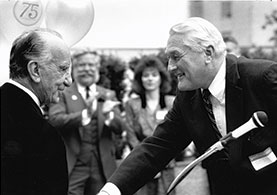
Pucci greets President Paul Bragdon at Reed’s 75th anniversary in 1987. (Note the blurry but still recognizable figure of Portland Mayor Bud Clark ’57 in the background.) Reed Hauser Library special collections
Emilio himself believed that his Reed education provided an invaluable foundation for working in fashion. “My MA at Reed, plus many other things I learned at Reed, are at the basis of my formation in my career,” he said in 1962. “Designing today means understanding life as it is today—understanding social, political, and economic problems of the world at large and understanding people as individuals—and if you do, your designing has that universal quality which is the best mark of good design.”
Emilio’s influence was lasting on both fashion and Reed. Although the fashion world tends to stereotype the Pucci style as part of the 20th-century zeitgeist, the New York Times declared “Pucci Is Relevant Again” after Beyoncé wore a boatnecked black gown at Obama’s inauguration. On Mount Hood, the Pucci chairlift and Pucci Glade commemorate a shared history. “Pucci’s really credited with bringing a sense of fashion to the ski world, and he locally pioneered a lot of those tailored ski pants and cuffed jackets that are still popular,” says Jon Tullis, spokesman for Timberline Lodge.
Without Emilio, President Keezer would probably never have authorized the construction of the Reed ski cabin, which still welcomes students and alumni after long days on the slopes. Emilio demonstrated his skiing ability to the skeptical President by boosting Keezer’s 6-year-old daughter Nan onto his relatively slight shoulders and whizzing down a Mount Hood slope. He triggered “something approaching an apoplectic seizure” in Keezer by coming to a “spectacular snow-showering stop”—a stunt that was sheer ecstasy for Nan.
- Previous Page
- 1
- 2
- Next Page

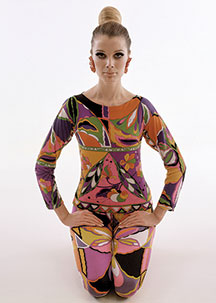
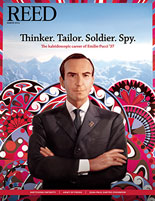
LATEST COMMENTS
steve-jobs-1976 I knew Steve Jobs when he was on the second floor of Quincy. (Fall...
Utnapishtim - 2 weeks ago
Prof. Mason Drukman [political science 1964–70] This is gold, pure gold. God bless, Prof. Drukman.
puredog - 1 month ago
virginia-davis-1965 Such a good friend & compatriot in the day of Satyricon...
czarchasm - 4 months ago
John Peara Baba 1990 John died of a broken heart from losing his mom and then his...
kodachrome - 7 months ago
Carol Sawyer 1962 Who wrote this obit? I'm writing something about Carol Sawyer...
MsLaurie Pepper - 8 months ago
William W. Wissman MAT 1969 ...and THREE sisters. Sabra, the oldest, Mary, the middle, and...
riclf - 10 months ago